Offshore Wind Turbines
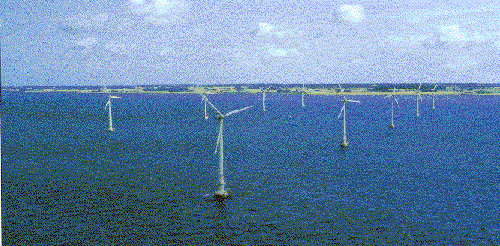
Vindeby photo: http://www.afm.dtu.dk/wind/turbines/gallery.html
Introduction
The total offshore wind resource, world wide, is huge.
The resource around the coast of Europe (based on 30km from land 40m water depth and up to 10 m/s)
is estimated to be 3028 TWh/year.
The UK has an offshore wind potential equal to three times its electricity demand.
Total UK offshore resource is estimated as 986 TWh/year while total demand is 321TWh/year.
Interest in tapping into this potential has grown in the last 20 years, partly spurred by
the success of onshore wind and also partly by problems facing onshore developers.
So far, four demonstration offshore windfarms have been commissioned:
Vindeby and TunÝ Knob, both Danish and Nogersund and Bockstigen, both Swedish.
Existing Offshore Wind Farms
Nogersund, Sweden - a world first
The worlds first offshore wind turbine was commissioned in 1990 in Sweden.
It was built as a test plant "in order to examine the influence of birds, fish and fishing, shipping, public opinion,
maintenance and the effects on foundations from wind and ice".
It lies about 250m out to sea, in 6m of water, from the fishing village of Nogersund southern Sweden.
It consists of a single 3-bladed Danish wind turbine with a hub height of 37.5m and rated ouput
of 220kW.
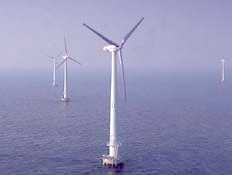
|
Vindeby, Denmark
The worlds first commercial offshore windfarm was commissioned in 1991 in Denmark.
It is in the Baltic sea a couple of kilometres NW of
the island of Lolland, near the village of Vindeby, in Denmark.
It was built by SEAS, has a capacity of 4.95MW and consists of 11 Bonus 450 kW stall controlled
wind turbines in two parallel rows from NW to SE
photo: http://www.afm.dtu.dk/wind/turbines/gallery.html
|
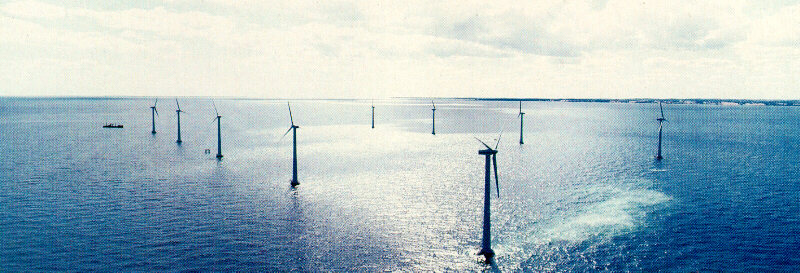
|
TunÝ Knob, Denmark
Subsequently, another offshore windfarm was
commissioned in 1995, TunÝ Knob, is in in the Kattegat Sea,
off the Danish coast.
It was built in 1995 by the Danish utility company Midtkraft, has a capacity of 5MW
and consists of 10 Vestas 500 kW pitch controlled wind turbines
photo:http://www.afm.dtu.dk/wind/turbines/gallery.html
|
Bockstigen, Sweden
The fourth and most recent offshore windfarm is Bockstigen, south of the island of Gotland
in Sweden. It has a capacity of 2.5MW
It was the first in the world to use the new monopile foundation technique.
This technique is cheaper than gravity foundations at water depths greater than about 10m and
should therefore help make offshore wind more economic.
Reasons for siting wind turbines offshore
Higher windspeed
Windspeeds offshore are typically 20% greater than those onshore.
That means higher electricity yield per wind turbine.
More often windy
It is less often calm offshore than onshore - increasing the amount of hours per
year that the turbine is generating electrcity.
That also means higher electricity yield per wind turbine.
Lower turbulence offshore
Because the sea is less rough
(no hills or trees for example) than the land, turbulence is generally
lower offshore, which is good for the turbine and means a longer turbine lifetime - lifetime is estimated to increase
from 25 years (onshore) to 30 years (offshore).
That also means higher elecricity yield per wind turbine.
Visual impact
Although most people are in favour of wind energy,
(asked in a recent study if they supported, in principle, wind farm development, 69% of people said yes, 29% had no opinion and only 2% opposed it)
(in a study after Britain's first wind farm, Delabole, was built, 85% were in favour and only 4% opposed)
controversy in the media over the visual impact of wind turbines has been one of the main obstacles to onshore windfarms in the UK
and has made planning permission difficult to obtain.
The most common objection to windfarms is that they spoil the landscape
and this has been enough to stop many being built.
This problem has been compounded by the governments' policy that potential developers
must enter into competitive tendering (under NFFO and
SRO) and that government will selectively support only those proposals for new wind farms with the
lowest p/kWh. Since lowest p/kWh is acheived
by putting turbines where windspeed is highest, most proposals have been to develop
the windiest and therefore the most exposed locations.
By being forced, through competition, to propose to erect
turbines in the most exposed (and often most beatiful) locations, potential developers have faced the maximum number of objections over visual impact
and have had the least chance of success.
Also, since each local authority has jurisdiction to grant (or not) planning permission to a windfarm
proposal in its area and since moving the proposed windfarm site by a few miles can mean a different local authority and a
new set of planners with different priorities, developers have faced problems. The lack of a
consistent national planning policy within which to work has made it more difficult to develop windfarms.
Siting turbines offshore, however, solves all these problems.
First, the turbines would have minimal visual impact, especially considering that
the vast majority of the population would never see them, although they would still
benefit from an improved environment in many other ways - the turbines would offset CO2
emissions and so reduce the effect of global warming, for example.
Also, the windiest offshore sites are those which are furthest away from land - so competitive
tendering could have the effect of driving windfarms further offshore and so minimising
visual impact.
Secondly, planning permission for new offshore developments are not be subject to local
authority approval but instead must be granted approval by The Crown Estate. Since all
potential offshore developers would apply to this one agency, whose decisions can be guided by
government, they would have a consistent planning policy (at least for offshore) which is required
if the wind industry is to grow in any substantial way.
Noise
Apart from objections over visual impact, most objections
to wind turbines have been that they are too noisy.
While the impact of audible noise is a very
subjective experience, operators of onshore turbines normally attempt to minimise
this disturbance by running the turbine at lower than optimum speed; with a great deal of success.
Also, the electromagnetic noise emitted by turbines
can interfere with television reception or microwave links. This can be avoided through careful planning and
the use of shielding.
Offshore, noise is of a far lesser concern and so turbines can be run at optimum speed to
maximise power output.
By siting turbines offshore, what were societal issues - visual impact and noise - become
technical and economic issues, which may be easier to solve.
It is now technicaly possible to erect a wind turbine offshore.
To do so required a turbine design which could withstand the marine environment, a turbine
which was rugged, dependable and needed little maintanance.
The Danish Manufacturers have succeeded in this.
It also required that the Balance Of System (foundation, transmission, switchgear) and
procedures for maintanace be able to fuction reliably in a marine environment. In this the
offshore wind industry has been able to learn from the offshore oil industry where there exists
many years experience of working in the marine environment.
Economics of Offshore Wind: Onshore vs. Offshore
After many years of feasibility studies, the Danish have shown that offshore wind really is feasible.
One problem with offshore wind, however, is the amount of money that must be spent on these Balance of System
components just to enable the turbine to be offshore.
Pictured below are some pie charts showing the breakdown of costs
for various real and projected windfarms.
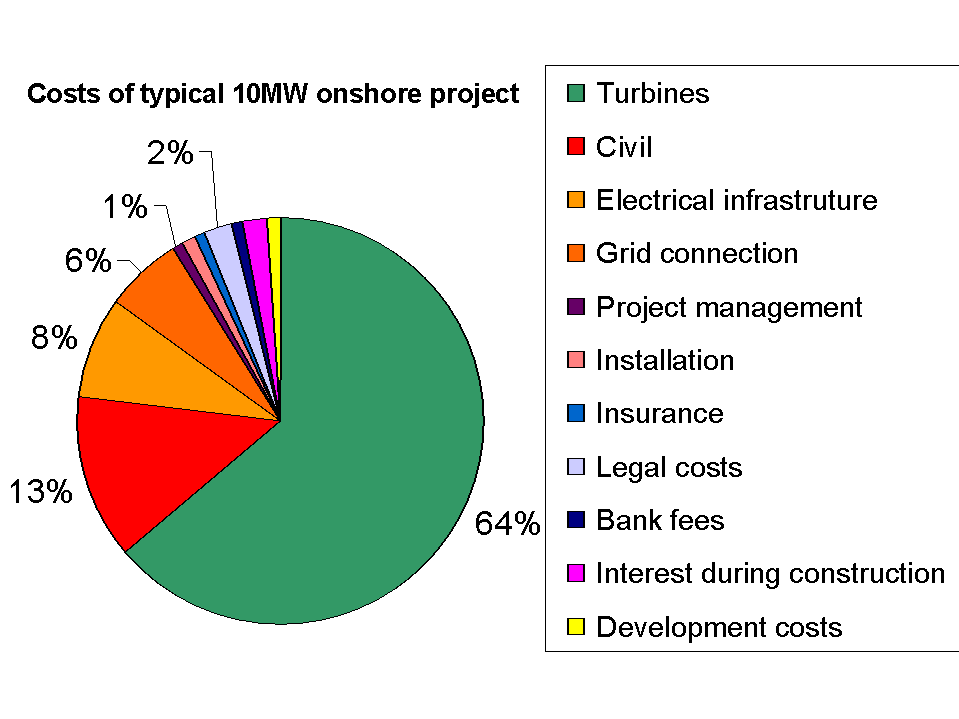
|
Typical Onshore costs
Shown here is a typical breakdown of costs for a 10MW onshore windfarm.
The turbines themselves account for 56% of the total budget with 13%
going on civil engineering (foundations), and 14% towards their electrical connection.
|
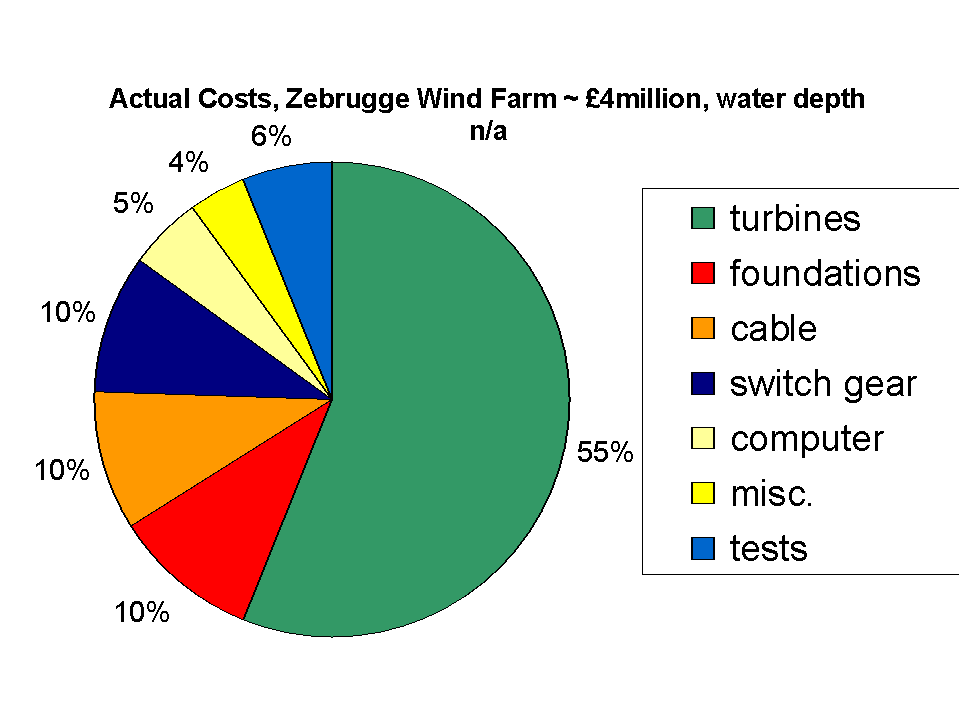
|
Zebrugge, Belgium
Although not strictly offshore, this was one of the first
projects to take advantage of pre-existing harbour breakwaters
as foundations for wind turbines.
In this way it was possible to take advantage of higher coastal windspeeds
while limiting the need for expensive foundations.
The project was commissioned in 1986 at a cost of some 5.9 million ECU's
It has a capacity of 4.6MW and consists of 23 * HMZ 200kW, pitch-controlled, 22.5m diameter, hub height of 22m , machines.
It can be seen that 20% of the total expenditure went on preparing
foundations and laying transmission cable, with a further 10% on switchgear.
Expenditure directly on the turbines themselves accounted for 55% of the budget,
which is reasonable.
Mean annual windspeed at 22m = 6.3 m/s.
Performance of the array is described as good.
|
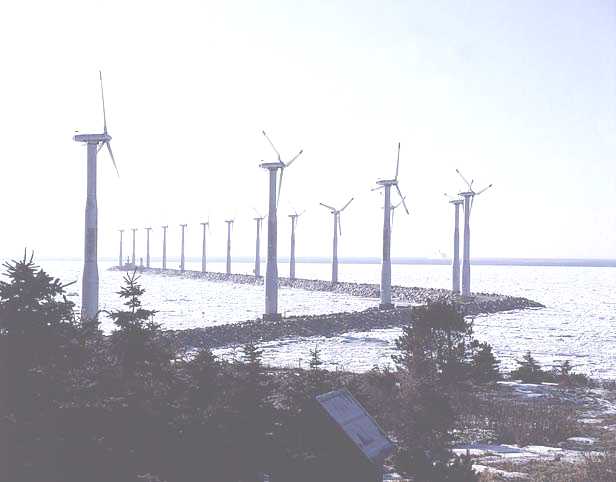
| This picture illustrates the principle of Zebrugge.
It shows Ebeltoft, the worlds first semi-offshore windfarm, built on a harbour pier
in Denmark in 1985. It consists of 16 Nordtank 55 kW
wind turbines and one 100kW.
Photograph copyright © 1981? NEG Micon A/S
|
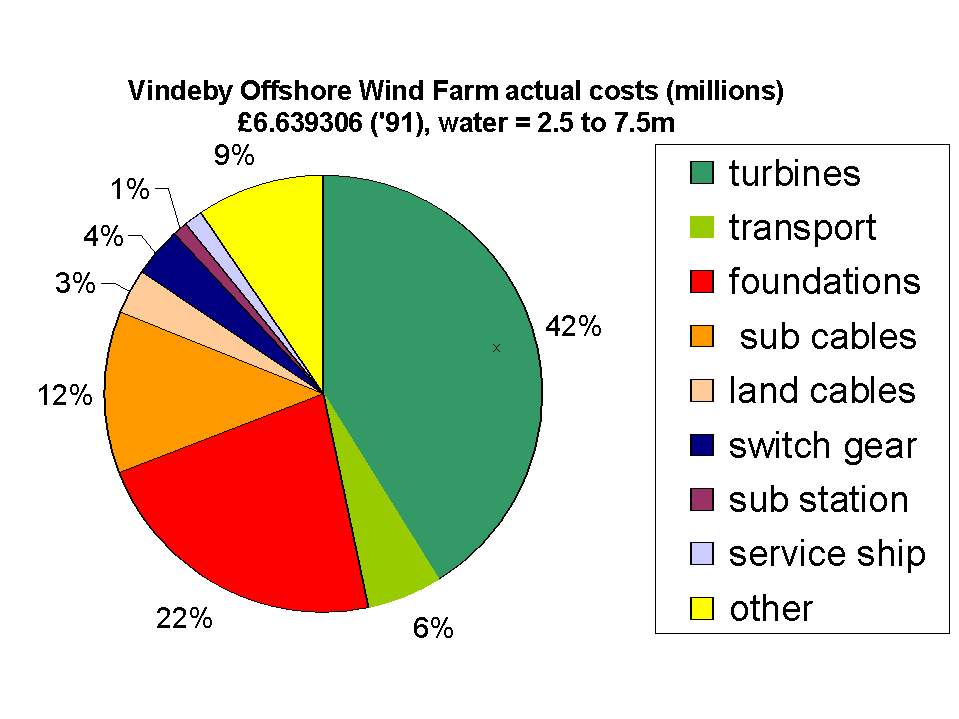
|
Actual Costs, Vindeby Offshore Windfarm, Denmark
The first offshore windfarm, Vindeby, was commissioned in the summer of 1991.
It is in the Baltic sea, a couple of kilometres off the coast of Denmark.
It was built by SEAS and consists of 11 Bonus 450 kW stall
controlled wind turbines.
Total costs 76.2 million DKK = £6.64 million (1991)
1DKK = £0.08713.
It can be seen that 42% of this was spent on the turbines, with
22% on foundations and 19% on electrcical connection.
|
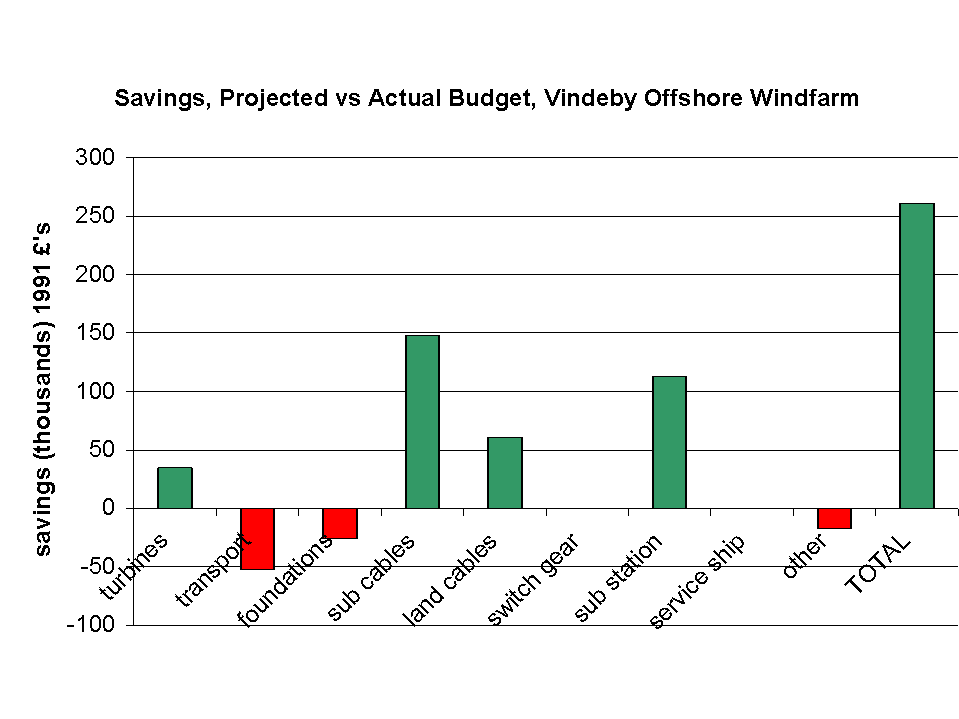
|
Projected versus actual costs,Vindeby
The cost of a kWh from Vindeby is estimated to be 1.6 times the cost of a
kWh from an equivalent onshore windfarm.
The project had actual costs of 76.2 million DKK versus projected costs
of 79.2 million DKK - These are £6.64 million and £6.90 million, respectively,
given an exchange rate in 1991 of 1DKK = £0.08713.
Overall the project budget undershot by the equivalent of £ 261 390.
The ability of all those who worked on the windfarm to bring such a novel
project in on time and under budget is a great example to the rest of the industry.
In fact, the only parts of the project to run over budget were transport
and foundations. The reason given for this is unexpectedly bad weather which
forced work to halt. This meant that transport was required for longer than planned
and that the foundation yard had to be kept operational for longer, making both
these categories run over budget.
|
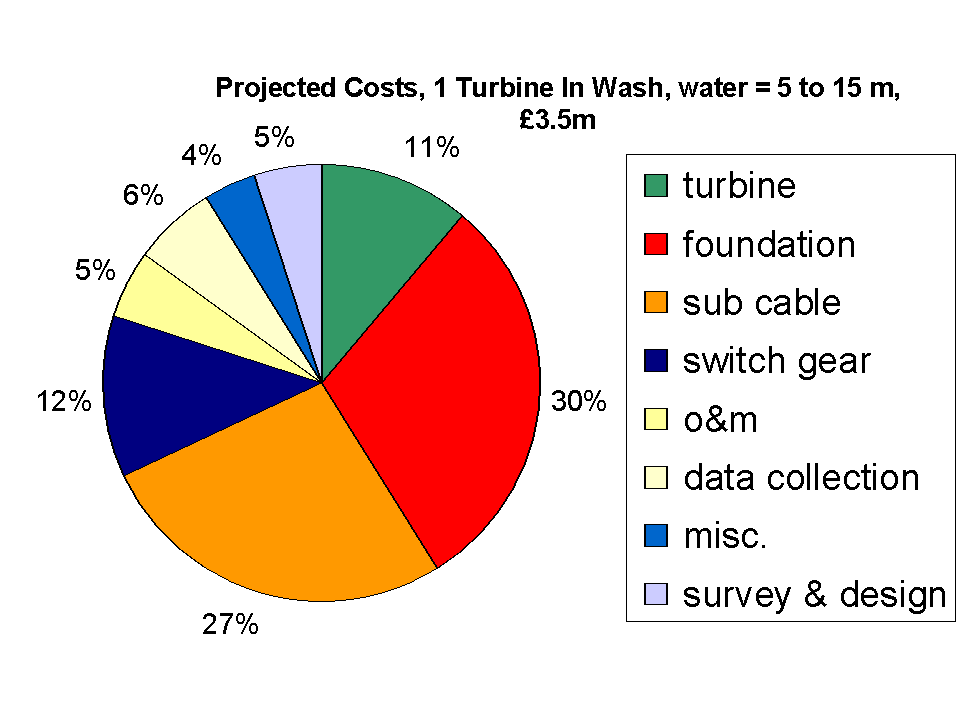
|
Projected costs, single turbine in Wash
These are projected costs from a study done in the early 90's.
looking at the feasibility of siting a single demonstration
wind turbine near the Wash, in the North Sea.
Both concrete gravity and steel tripod type foundations were considered in the course of
the study.
The concrete gravity base was preferred because it was considered
"...more representative of the structures anticipated
for multimegawatt offshore turbines."
Although never commissioned, the projected
budget was £3.5 to £4 million and included operation, maintenance and
data collection costs for two years.
It can be seen that 57% was projected for foundations and transmission cable, with a further 12% on switchgear.
Expenditure directly on the turbines themselves would account for only 11% of the budget,
which is extremely low considering that this is the only part which will earn you an money
|
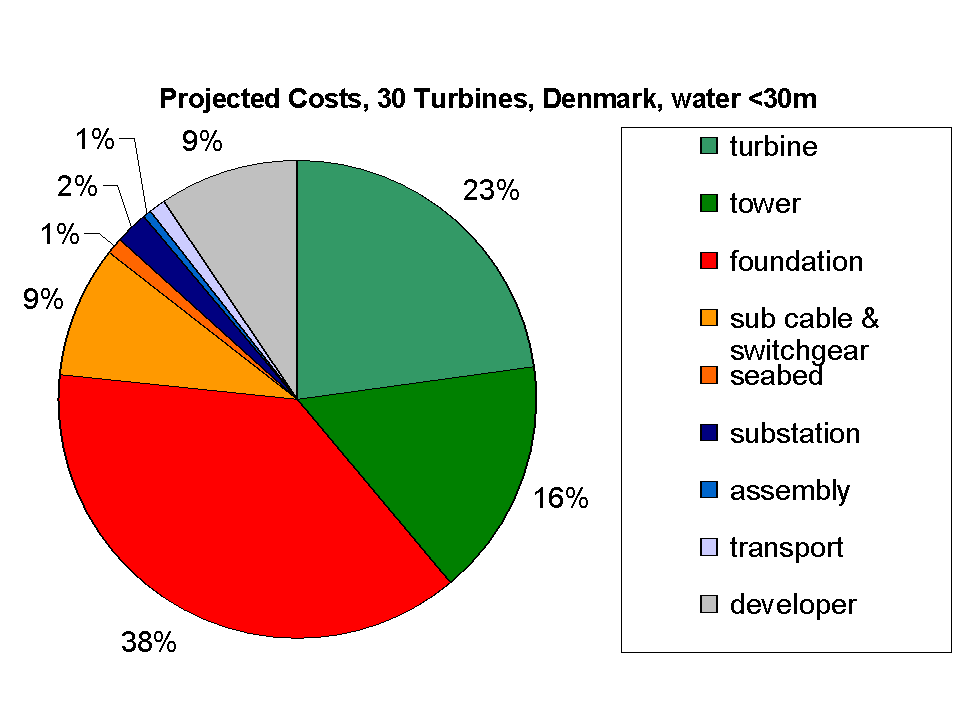
|
Projected costs, 30 turbines offshore,Denmark
This was a study carried out in the early 1980's.
It gave projected costs for a proposed windfarm consisting
of 30 * 7MW turbines, 25km from shore and in water depth of not more
than 30m. With these parameters and other parameters relating to
maximum environmental loading and turbine characteristics etc., and not
for a specific site itself, the project budget was estimated.
This study saw 50% of the total budget ( $287 million (1980))
being spent on foundations and transmission, 16% on the tower,
9% going to the developer and only 23% being spent on the turbines.
|
Offshore more expensive than onshore
It can be seen from the above pie charts that as turbines are moved offshore and as water depth increases,
an increasing percentage of the project budget must be spent on foundations and transmission (submarine cables) and less and less
on the turbines themselves.
Foundation costs for Vindeby were 22.4%, compared with an average of 5 - 7% and 10% for semi-offshore and onshore respectively. These costs increase as water depth increase.
So despite the fact that offshore wind turbines have a higher capacity coefficient (where capacity coefficient = average electrcity generation per hour / rated power output of turbine)
and longer lifetime and this tends to reduce p/kWh costs, the increased percentage expenditure on foundations and transmission means less is spent on the turbines and this tends to increase p/kWh costs and
mean that an offshore wind kWh is more expensive than the equivalent onshore.
For example, the price of energy from Vindeby is 0.59DKK/kWh or about 5.14p/kWh.
This compares with 0.37DKK/kWh or about 3.22p/kWh from a Danish onshore windfarm.
To compare these costs, a new coal fired plant built now, assuming a 10% cost of capital,
would cost between 4.6 - 5.1 p/kWh. New nuclear PWRs are 4.2 - 6.6p/kWh. New CCGT are 2.4 - 2.8 p/kWh. These figures do not include external costs associated with conventional generation, which have been estimated to add a further 0.42, 0.175 and 0.056 p/kWh to coal, nuclear and gas respectively.
Wind generation has associated external costs of 0.00 (zero) p/kWh.

|
Ratio kWh cost offshore/onshore wind
For Example
A kWh from Vindeby has been estimated to cost between 1.25 and 1.6 times more than a kWh from an equivalent Danish onshore windfarm while the cost of a kWh from TunÝ Knob is estimated to be 2.2 times as much.
Numerous other studies carried out in the last 20 years have suggested that an offshore wind
kWh is between 1.1 and 2.9 times as expensive as an onshore wind kWh.
This ratio is expected to decrease further in future, with the cost of Danish offshore wind expected to fall to 3.4 to 4 p/kWh while British costs, higher because of an relatively larger expected rate of return by the UK financial industry, are predicted to be 5 to 6 p/kWh.
|
Future reduction in the cost of offshore wind
The cost of offshore wind is expected to fall because of:
- increasing turbine size
- optimisation of windfarm size
- cheaper foundation design
- improved construction techniques
- better reliability
- cheaper underwater cabling
- better transport systems
- longer turbine life
- re-using foundations
Environmental Impact of Offshore Wind
Offshore wind farms must be compatible with both human society and with the natural environment.
Wind farms must be developed sensitively and in consultation with local communities.
The scale of developments ahould be in keeping with the nature of the landscape amd the distribution of habitation within it.
When potential sites are evaluated, account must be taken of :
- societal constraints including coastal towns, harbours, airports, aircraft and ship navigation, military defense, fishing and acquaculture, fishing, oil platforms, recreational activities, marine archeological an historical areas, marine geology, electromagnetic and TV interference.
- (a very accurate assessment of) environmental impact including bird life (local, migratory, breeding), fish life (local, migratory, spawning), sea bed vegetation (algae etc.), visual intrusion, noise and social acceptance.
Then suitable exclusion zones must be drawn up on the basis of these issues.
Studies carried out in the last 8 years for offshore windfarms, of no more than 26 turbines, in North European Waters,
have shown the following trends.
- minor effect on migratory birds
- improved habitat for fish around the turbine foundations (cod at Vindeby)
- acceptable visual impact (for windfarms more than 2km from the coast)
- no noise problem
- low or no radio communication/TV problem
- good social acceptance by population and fishermen
- new job opportunity for seamen
Birds and Wind Turbines
It was decided to build the a turbine offshore from Nogersund in Sweden specifically because it is in the
centre of a migration path used twice a year by millions of birds.
In spring migrating birds pass the site in groups, flying SW to NE and at about 20 to 30m above sea level. Amongst other studies which were carried out at the time,
one study involved counting the
number of birds during spring migration, flying NE past the site, and their approximate distance from the turbine. This was done in 1990 and 1991.
The complete study into the effect of offshore wind turbines on birds lasted 5 years and ended in 1995.
It concludes that "breeding birds and resting birds are too few in the area to make a statistically valid test" but that
"migratory birds try to avoid the plant by flying further out from the coast line over the sea. Thus within a distance of 500m
from the plant (placed 250m out from the coast line) the number of birds were reduced by almost 50% after erection of the plant".
The conclusion of the RSPB after studying the effects of wind turbines is that the impact on birds
is "similar to that of many structures". They also refer to studies which show that numbers of birds killed per kilometre of windfarm
are similar to those killed per kilometre of road. Birds local to a wind farm appear to recognise
its existence and avoid it although care should be taken not to site a farm on a sensitive migration route.
From these and other studies it is possible to conclude that the effect of wind turbines on birds is relatively minor, however care should be taken
to ensure that sensitive locations are avoided and that further studies should be commissioned for specific projects if necessary and on
the advice of respected ornithologists..
Offset Emissions and Wind Turbines
If 10% (12 000MW) of the UK's electricity was generated from the wind, this would offset, each year
- 30,000,000 tons of carbon dioxide
- 2,000,000 tons of slag and ash
- 80,000 tons of sulphur dioxide
- 40,000 tons of nitrous oxides
which is equal to 15% of the UK's annual emissions due to power generation.
Energy Balance of Offshore Wind Turbines
The Danish Wind Turbine Manufacturers Association have calculated that an offshore wind turbine can recover all the energy used in its manufacture, transport, installation, operation, maintenance over its lifetime and then decommissioning and recovery of materials about 3 months. They also calculate that during its lifetime the turbine will generate over 100 times the energy spent on it in these operations.
Employment by Offshore Wind
The fuel is free but offshore wind is both capital and labour intensive.
It has been estimated (European News, 1995) that a total of 22 jobs are created for each MW installed,
with 17 jobs/MW created for construction and 7 jobs/MW created for operation at local level.
Recent figures (reported in "Offshore Wind Energy - Building a New Industry for Britain" - Border Wind 1998) estimate 4.52 jobs per MW and 36 160 jobs created either directly or indirectly in the UK by offshore wind, by 2010.
UK Offshore Wind
The UK currently has no offshore wind turbines. A 2.7 MW semi-offshore windfarm was constructed along an existing breakwater at Blyth Harbour in 1992. This work was carried out by Border Wind. The same company are now (summer 1999) in the process of commissioning Britains first offshore windfarm, which will also be the first in the North Sea, consisting of 2 750kW wind turbines installed at a water depth of 8m and with tidal range 5m.
Offshore Wind Quotes
"2000 large wind turbines, half of them offshore, will be built for Britain in the next 10 years"
- Michael Meacher, Environment Minister, Buenos Aires, 17 November 1998.
"We're convinced the future is in going offshore" - Bill Grainger, Technical Director, Border Wind













